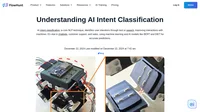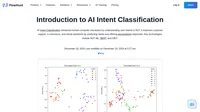Semantic Analysis is a complex process employed within the framework of Natural Language Processing (NLP) to interpret and derive meaning from text. It involves the identification and understanding of the words, phrases, and sentences in human language. The core purpose is to enable machines to comprehend language in a manner similar to human understanding, which includes recognizing context, emotions, sentiments, and other nuanced aspects of language.
Key Components of Semantic Analysis
- Lexical Semantic Analysis: This involves the study of individual words and their dictionary meanings. It focuses on understanding the meaning that a word is assigned within a text.
- Compositional Semantics: This part extends beyond individual words to understand how combinations of words create meaning in a sentence. For example, “Students love GeeksforGeeks” and “GeeksforGeeks loves Students” have different meanings despite similar word usage.
- Contextual Understanding: Semantic analysis doesn’t just look at words in isolation but considers context by examining surrounding words and sentences. Context helps resolve ambiguities where a word might have multiple meanings.
- Word Sense Disambiguation: This is a crucial part of semantic analysis. It involves determining which meaning of a word is active in a given context. For example, the word “bark” can refer to a tree’s outer layer or a dog’s sound, and context helps clarify which is intended.
How Semantic Analysis Works
Semantic analysis starts by processing text to identify each word’s grammatical role. It then examines relationships between words to understand the structure and meaning of sentences. For instance, “The boy ate the apple” clearly defines an apple as a fruit, whereas “The boy went to Apple” refers to a brand or store entity.
This process includes:
- Lexical Analysis: Converts characters into a format understandable by machines.
- Syntactical Analysis: Analyzes sentence structure using grammar rules.
- Semantic Analysis: Integrates all previous processes to assign meaning to text, ensuring machines understand language contextually.
Applications of Semantic Analysis
- Chatbots and Virtual Assistants: These tools use semantic analysis to understand user queries and provide appropriate responses. They are pivotal in customer service and support scenarios.
- Search Engines: Semantic analysis enables search engines to comprehend user intents, providing results based on context rather than mere keyword matching.
- Sentiment Analysis: Used by social media platforms and businesses to assess public sentiment or emotional tone from user-generated content.
- SEO Optimization: Helps in refining content strategies by understanding user intent and delivering contextually relevant content.
- Data Analysis: Extracts insights from unstructured data such as emails and customer reviews, aiding in business decision-making processes.
Advantages of Semantic Analysis
- Enhanced Understanding: Provides deeper insights into text, capturing nuances that simple keyword detection might miss.
- Improved NLP Tasks: Essential for tasks like machine translation, sentiment analysis, and document summarization.
- User Experience: By delivering context-aware responses, semantic analysis enhances the interaction quality in user interfaces like chatbots.
Challenges and Considerations
Semantic analysis is not without its challenges. The complexity of human languages, including idiomatic expressions and cultural nuances, poses a significant hurdle for machines. Moreover, ensuring high accuracy in understanding context and meanings requires sophisticated algorithms and models.
Overall, semantic analysis is a cornerstone of modern NLP, enabling machines to process and interpret language data effectively, thereby facilitating better communication between humans and machines. This powerful tool not only enhances technological applications but also transforms how businesses engage with their customers by providing deeper insights and more personalized interactions.
Research on Semantic Analysis
Semantic Analysis is a crucial field in understanding and processing natural language, focusing on the meaning of words, phrases, and sentences within their context. Several scientific studies have contributed to the development of this field, providing insights and methodologies for advancing semantic understanding.
- Towards Universal Semantic Tagging
This paper by Lasha Abzianidze and Johan Bos explores the concept of universal semantic tagging, which involves tagging word tokens with language-neutral, semantically informative tags. The research argues that this approach enhances semantic analysis across multilingual texts. The authors present a semantic tagset and demonstrate its utility in providing semantically fine-grained information suitable for cross-lingual semantic parsing. The study includes an application of semantic tagging in the Parallel Meaning Bank, showing its contribution to formal lexical semantics and cross-lingual projection. A small corpus is annotated with these semantic tags, establishing a new baseline for universal semantic tagging. Read more - Weakly Complete Semantics Based on Undecidedness Blocking
Authored by Pierpaolo Dondio and Luca Longo, this paper introduces weakly complete semantics, differing from traditional complete semantics by employing undecidedness blocking. This mechanism prevents the propagation of undecided labels from attacking arguments to attacked arguments, thus maintaining conflict-free but non-admissible semantics. The study highlights how these semantics can be generated through various undecidedness blocking strategies, offering a unifying mechanism for argumentation semantics. The paper compares these semantics with recent work on weakly admissible semantics, providing a principle-based analysis that underscores their adherence to several principles of traditional complete semantics. Read more - Semantic Measures for the Comparison of Units of Language, Concepts or Instances from Text and Knowledge Base Analysis
Written by Sébastien Harispe et al., this paper delves into semantic measures used to evaluate the semantic relationship strength between language units, concepts, or instances. Semantic measures are critical in comparing these elements based on semantic proxies like texts and knowledge representations. The paper provides a comprehensive survey of semantic measures, which generalize semantic similarity, relatedness, and distance. These concepts have been extensively studied across disciplines such as Cognitive Sciences, Linguistics, and Artificial Intelligence, making semantic measures instrumental in developing intelligent agents capable of semantic analysis. Read more
Understanding AI Intent Classification
Unlock the potential of AI intent classification with FlowHunt. Enhance chatbot efficiency, customer support, and user experience today!
Introduction to AI Intent Classification
Discover how AI Intent Classification enhances interactions, boosts user satisfaction, and streamlines business operations across various sectors.
Let AI Take The Guesswork Out of SEO
Boost your SEO with FlowHunt's AI tools! Research keywords, analyze competitors, create briefs & optimize content effortlessly. Try now!"



